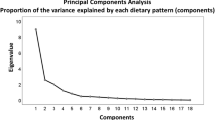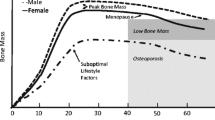Abstract
Summary
Youth with type 2 diabetes might have suboptimal peak bone mass, but it is unknown whether similar effects are evident in youth with prediabetes. Results from this study suggest that diabetes-related effects on peak bone mass likely occur before disease onset, and involve the muscle-bone unit.
Introduction
Type 2 diabetes might adversely influence bone health around the age of peak bone mass, but it is unknown whether diabetes-related effects on areal bone mineral density (aBMD) are evident in youth with prediabetes. We compared age-related trends in aBMD and associations between lean body mass (LBM) and aBMD between children and adolescents with prediabetes vs. normal glucose regulation.
Methods
Cross-sectional analysis of data from the National Health and Nutrition Examination Survey (2005–2006) in youth ages 12–20 years (49% female, 34% black) with prediabetes (n = 267) and normal glucose regulation (n = 1664). Whole body aBMD and LBM were assessed via DXA. LBM index (LBMI) and Z-scores for aBMD and LBMI were computed.
Results
Unadjusted between-group comparisons revealed greater mean weight and LBMI Z-scores in youth with prediabetes vs. normal glucose regulation, but similar bone Z-scores between the two groups. While accounting for differences in BMI Z-score, there was a significant interaction between prediabetes status and age with respect to whole body aBMD Z-score (P < 0.05), such that children with prediabetes tended to have increased aBMD but adolescents and young adults with prediabetes tended have lower aBMD. Furthermore, the positive association between LBMI and whole body aBMD was moderated in youth with prediabetes (P < 0.001), who had slightly lower whole body aBMD for a given LBMI (P = 0.068). Lumbar spine bone measures did not differ between the two groups.
Conclusions
Type 2 diabetes-related threats to peak bone mass might occur prior to disease onset, therefore potentially impacting a considerable proportion of US youth.


Similar content being viewed by others
Data availability
All data are available through the study webpage.
Code availability
All codes are available upon request.
References
Weaver CM et al (2016) The National Osteoporosis Foundation’s position statement on peak bone mass development and lifestyle factors: a systematic review and implementation recommendations. Osteoporos Int 27(4):1281–1386
Hales CM et al (2017) Prevalence of obesity among adults and youth: United States, 2015–2016. NCHS Data Brief 288:1–8
Mayer-Davis EJ et al (2017) Incidence trends of type 1 and type 2 diabetes among youths, 2002–2012. N Engl J Med 376(15):1419–1429
Andes LJ et al (2020) Prevalence of prediabetes among adolescents and young adults in the United States, 2005–2016. JAMA Pediatr 174(2):e194498
Chen C et al (2020) Trends in bone mineral density, osteoporosis, and osteopenia among U.S. adults with prediabetes, 2005–2014. Diabetes Care 43(5):1008–1015
Schwartz AV et al (2011) Association of BMD and FRAX score with risk of fracture in older adults with type 2 diabetes. JAMA 305(21):2184–2192
Kindler JM, Kelly A, Khoury PR, Levitt Katz LE, Urbina EM, Zemel BS (2020) Bone mass and density in youth with type 2 diabetes, obesity, and healthy weight. Diabetes Care 43(10):2544–2552
Kindler JM, Lewis RD, Hamrick MW (2015) Skeletal muscle and pediatric bone development. Curr Opin Endocrinol Diabetes Obes 22(6):467–474
Gordon CM et al (2014) 2013 Pediatric Position Development Conference: executive summary and reflections. J Clin Densitom 17(2):219–224
Pollock NK et al (2010) Lower bone mass in prepubertal overweight children with prediabetes. J Bone Miner Res 25(12):2760–2769
Afghani A, Cruz ML, Goran MI (2005) Impaired glucose tolerance and bone mineral content in overweight latino children with a family history of type 2 diabetes. Diabetes Care 28(2):372–378
Leslie WD et al (2012) Type 2 diabetes and bone. J Bone Miner Res 27(11):2231–2237
Centers for Disease Control and Prevention, N.C.f.H.S. NHANES 2005–2006. March 1, 2021]; Available from: https://wwwn.cdc.gov/nchs/nhanes/continuousnhanes/default.aspx?BeginYear=2005. Accessed 1 Nov 2020
American Diabetes A (2014) Diagnosis and classification of diabetes mellitus. Diabetes Care 37(Suppl 1):S81-90
Kuczmarski RJ et al (2000) CDC growth charts: United States. Adv Data 314:1–27
Crabtree NJ et al (2014) Dual-energy X-ray absorptiometry interpretation and reporting in children and adolescents: the revised 2013 ISCD Pediatric Official Positions. J Clin Densitom 17(2):225–242
Kindler JM, LJ, Gilsanz V, Oberfield S, Shepherd JA, Kelly A, Winer KK, Kalkwarf HJ, Zemel BS. Data from: lumbar spine bone mineral apparent density in children: results from the bone mineral density in childhood study. 2018 August 2018]; Available from: 10.6084/m9.figshare.6954992.v1.
Zemel BS et al (2011) Revised reference curves for bone mineral content and areal bone mineral density according to age and sex for black and non-black children: results of the bone mineral density in childhood study. J Clin Endocrinol Metab 96(10):3160–3169
Zemel BS et al (2010) Height adjustment in assessing dual energy x-ray absorptiometry measurements of bone mass and density in children. J Clin Endocrinol Metab 95(3):1265–1273
Weber DR et al (2013) Fat and lean BMI reference curves in children and adolescents and their utility in identifying excess adiposity compared with BMI and percentage body fat. Am J Clin Nutr 98(1):49–56
McCormack SE, Cousminer DL, Chesi A et al (2017) Association between linear growth and bone accrual in a diverse cohort of children and adolescents. JAMA Pediatr 171(9):e171769
Devlin MJ et al (2014) Early-onset type 2 diabetes impairs skeletal acquisition in the male TALLYHO/JngJ mouse. Endocrinology 155(10):3806–3816
Pollock NK (2015) Childhood obesity, bone development, and cardiometabolic risk factors. Mol Cell Endocrinol 410:52–63
Jackowski SA et al (2009) Peak lean tissue mass accrual precedes changes in bone strength indices at the proximal femur during the pubertal growth spurt. Bone 44(6):1186–1190
Buckinx F et al (2018) Pitfalls in the measurement of muscle mass: a need for a reference standard. J Cachexia Sarcopenia Muscle 9(2):269–278
Kalkwarf HJ, Laor T, Bean JA (2011) Fracture risk in children with a forearm injury is associated with volumetric bone density and cortical area (by peripheral QCT) and areal bone density (by DXA). Osteoporos Int 22(2):607–616
Jones IE et al (2002) How many children remain fracture-free during growth? a longitudinal study of children and adolescents participating in the Dunedin Multidisciplinary Health and Development Study. Osteoporos Int 13(12):990–995
Kindler JM et al (2019) Lumbar spine bone mineral apparent density in children: results from the bone mineral density in childhood study. J Clin Endocrinol Metab 104(4):1283–1292
Ohlsson C, Bygdell M, Celind J et al (2019) Secular trends in pubertal growth acceleration in Swedish boys born from 1947 to 1996. JAMA Pediatr 173(9):860–865
De Leonibus C et al (2014) Timing of puberty and physical growth in obese children: a longitudinal study in boys and girls. Pediatr Obes 9(4):292–299
Bacha F et al (2010) From pre-diabetes to type 2 diabetes in obese youth: pathophysiological characteristics along the spectrum of glucose dysregulation. Diabetes Care 33(10):2225–2231
Pramojanee SN et al (2014) Possible roles of insulin signaling in osteoblasts. Endocr Res 39(4):144–151
Nadeau KJ et al (2016) Youth-onset type 2 diabetes consensus report: current status, challenges, and priorities. Diabetes Care 39(9):1635–1642
Author information
Authors and Affiliations
Corresponding author
Ethics declarations
Ethics approval
All procedures performed in studies involving human participants were in accordance with the ethical standards of the institutional and/or national research committee and with the 1964 Helsinki declaration and its later amendments or comparable ethical standards.
Consent to participate
Informed consent/assent was obtained from all individual participants included in the study.
Conflict of interest
None.
Additional information
Publisher's Note
Springer Nature remains neutral with regard to jurisdictional claims in published maps and institutional affiliations.
Rights and permissions
About this article
Cite this article
Kindler, J., Zhan, D., Sattler, E.L.P. et al. Bone density in youth with prediabetes: results from the National Health and Nutrition Examination Survey, 2005–2006. Osteoporos Int 33, 467–474 (2022). https://doi.org/10.1007/s00198-021-06148-2
Received:
Accepted:
Published:
Issue Date:
DOI: https://doi.org/10.1007/s00198-021-06148-2




